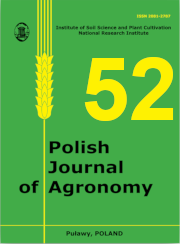Fungal community change in selected fluvisols under simulated flooding condition
Main Article Content
Abstract
The soil mycobiome is an important part of the numerous biogeochemical processes taking place in the soil. Its activity and diversity are influenced by many factors, including soil moisture. In this study, the effect of a 14-day simulated flood on the mycobiome of three different Fluvisols in microcosm experiment was assessed using next-generation sequencing. The results obtained showed that excessive moisture alters the structure of the mycobiome and the amounts of pathogenic, parasitic, and endophytic fungi. Among others, an increase in the occurrence of saprotrophic fungi of the genera Trichoderma, Talaromyces, and Schizothecium was noted. At the same time, the study showeda decrease in the abundance of arbuscular mycorrhizal fungi from the phylum Glomeromycota and Mucoromycota as a result of flooding. In addition, the structure of the soil mycobiome has been shown to be closely related to soil type – statistically significant correlations of individual fungal genera with the clay and silt or sand content of the soil were obtained. Future research on the soil mycobiome under flooding conditions may help to understand changes in soil biogeochemical processes following flooding, the occurrence of which is increasing with climate change.
Article Details

This work is licensed under a Creative Commons Attribution-ShareAlike 4.0 International License.
The author grants the editorial staff of the Polish Journal of Agronomy (abbreviated as PJA) a non-exclusive and royalty-free license to use the author's copyright in the paper/printed and electronic versions of his/her work published in PJA in Poland and abroad, in whole or in any part, including placing the work in electronic databases/databases locally or available on the Internet, for an unlimited period of time in the fields of exploitation specified in article 50 of the Copyright and Related Rights Act.
Manuscripts published in Polish Journal of Agronomy are available under a Creative Commons Attribution-ShareAlike 4.0 (CC-BY-SA) license.

